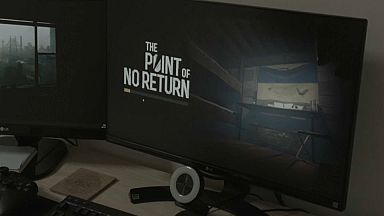A Ukrainian video game depicts the daily routine of a soldier in the country's separatist-controlled east, where Russia-backed rebels and Ukrainian forces have been fighting for years.
A Ukrainian video game depicts the daily routine of a soldier in the country's separatist-controlled east, where Russia-backed rebels and Ukrainian forces have been fighting for years.
The game is intended to help others understand the challenges soldiers struggling with post-war trauma are facing.
Video games are often violent, featuring war and bloodshed.
But "The Point of No Return", by visual storyteller and video game designer Alexey Furman, isn't like most games.
The project is focused on educating those who haven't been to a war zone about soldiers' experiences there, and also helping people close to war veterans understand what they have been through.
"You are playing as a man who makes a decision to enlist, to go to the war zone. And then he goes to the war zone and spends some significant time out there. And comes back home with a mental and physical trauma," explains Furman.
The game is created in the popular RPG (role-playing game) style, but, according to its developers, it is nothing like a classic war game.
It's designed to show the real atmosphere soldiers face on the frontlines, visualising real locations and details Ukrainian soldiers see during service.
Furman says the game is aimed at breaking the emotional barriers between those who have been at war, and those who haven't.
"What I'm trying to do with 'The Point of No Return' is sort of build bridges between the war veterans and the experience that they have gone through, with the people who have not been to the war zone, who do not know what it's like to be under mortar shelling every day," he says.
It's particularly relevant in Ukraine, where thousands of servicemen have taken part in the conflict in the country's separatist-controlled east over the last six years.
The conflict in Ukraine's mostly Russian-speaking industrial east, called Donbass, erupted in April 2014, weeks after Russia's annexation of the Crimean Peninsula.
More than 14,000 people have been killed in fighting between Ukrainian forces and Russia-backed separatists.
The game is based on the experiences of several real characters. Their stories have been combined.
One of real characters behind the game is Dmytro Bondar, an ex-serviceman who also helped voice "The Point of No Return".
Bondar also played a role in making sure the game's visuals are as close to reality as possible. He went through countless images from Donbass, including nature, locations, and weapons.
"(When creating the game) we were looking for visual references from the reality, starting with the nature, objects, weapons, ammunition, various kinds of boxes etc.," he says.
The project, which cost a little over $30,000 USD, was financed and supported by the Ukrainian Cultural Fund.
Representative Yanina Aleeva says the video game format allows users to experience things in a different way.
"This is sort of a workout machine, which a person, according to their own temperament, can choose various options of how events will unfold, in order to live through this from the perspective of their own experience," she says.
"This format (a video game) has these possibilities which other formats may lack."
"The Point of No Return" was presented to the public this autumn. It's on PC and free to play.












